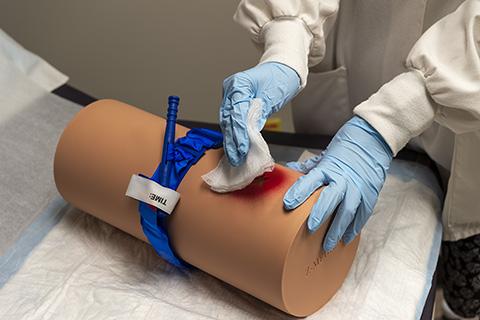This week, Werner H. Kirsten student interns Emme Tissue and Esteban Garcia are launching a training course that could mean the difference between life and death.
The duo will teach a class on halting uncontrolled bleeding in individuals who have experienced traumatic injuries such as gunshot wounds or major lacerations. The course is part of the official Stop the Bleed Program, an international initiative that seeks to reduce the number of deaths from traumatic bleeding by training civilians to provide on-site care to the injured. All NCI at Frederick and Frederick National Laboratory employees are eligible to enroll—no prior training required.
Trauma remains the leading cause of death worldwide in people younger than 45, and incidents of uncontrolled bleeding account for a significant proportion. Many occur on location, in transit to a trauma center, or shortly after arrival, often due to bystanders failing to act or stop a victim’s catastrophic bleeding while waiting on medical professionals to arrive.
“The truth is that emergencies happen, and sometimes emergency medical services cannot make it to a scene in time to save a life,” Tissue said. “By taking the training course, an employee can turn their hands into lifesaving tools.”
Tissue and Garcia, both licensed instructors through Stop the Bleed, will lead the hands-on course at three locations. They will be assisted by associate instructors Ron Kunz, emergency manager, and Sarah Hooper, Occupational Health Services manager. Interested FNL employees must register to attend through JASPER. Government employees should contact Kunz to register. Course times and locations are as follows:
- May 7, 2:00–3:30 p.m. – NCI at Frederick Campus, Building 549 auditorium
- May 10, 12:30–2:00 p.m. – Advanced Technology Research Facility, auditorium
- May 23, 1:30–3:00 p.m. – Vaccine Pilot Plant, administrative conference room
“The Stop the Bleed campaign, in my opinion, is a large step in the right direction in response to mass shootings. Being an instructor makes me feel like a part of the effort in fighting back,” Garcia said just two days after a shooting at Chabad of Poway synagogue in California that left one person dead and three others injured.
Stop the Bleed originally developed the course in response to incidents of gun violence, but the interns, their co-instructors, and others have recognized its usefulness in additional situations. Participants will learn how to pack wounds and use tourniquets, skills they can apply during shootings but also during more common incidents, like severe car accidents and major workplace injuries.
“You could save a life,” Hooper said.
“And it could even be your own,” Kunz added. “If you can’t save somebody else, you can at least help yourself.”
The course is part of NCI at Frederick’s larger observance of National Stop the Bleed Month, which began on May 1. In addition to teaching the course, Tissue, Garcia, Kunz, and Hooper have worked with other NCI at Frederick staff to install gauze kits in every automated external defibrillator case at NCI at Frederick and FNL so trained employees can help in an emergency. They have also provided each Protective Services office with a full Stop the Bleed kit, which contains wound-packing materials and tourniquets.
For more information about the courses, contact Ron Kunz at (301) 228-4216.
About Stop the Bleed
The Stop the Bleed Program® was born from the concept that survival rates could be increased during active shooter and intentional mass casualty events. After a series of mass casualty events, including the loss of 28 lives at Sandy Hook Elementary School, a group comprising the American College of Surgeons, the federal government, law enforcement, and others in the medical community devised the Hartford Consensus in 2013. This document defines the acronym “THREAT” as a method to control life-threatening bleeding (threat suppression, hemorrhage control, rapid extrication to safety, assessment by medical providers, and transport to definitive care). The Consensus also determined that immediate responders (bystanders) should become “trained, equipped, and empowered” to aid those experiencing external hemorrhaging in an emergency before medical professionals arrive. Stop the Bleed’s mission is to enhance the survivability rates of mass casualty events by training the public and supplying Stop the Bleed kits to public facilities.


